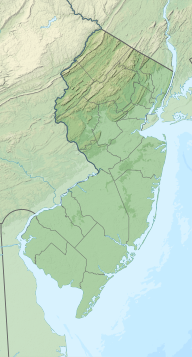
Hume Dam, formerly the Hume Weir, is a major dam across the Murray River downstream of its junction with the Mitta River in the Riverina region of New South Wales, Australia. The dam's purpose includes flood mitigation, hydro-power, irrigation, water supply and conservation. The impounded reservoir is called Lake Hume, formerly the Hume Reservoir. It is a gated concrete gravity dam with four earth embankments and twenty-nine vertical undershot gated concrete overflow spillways.

The Oradell Reservoir is a reservoir formed by the Oradell Reservoir Dam on the Hackensack River in Bergen County, New Jersey, United States.

Diamond Valley Lake is a man-made off-stream reservoir located near Hemet, California, United States. It is one of the largest reservoirs in Southern California and one of the newest. It has a capacity of 800,000 acre-feet (990,000,000 m3). The lake nearly doubled the area's surface water storage capacity and provides additional water supplies for drought, peak summer, and emergency needs.

The Mactaquac Dam is an embankment dam used to generate hydroelectricity in Mactaquac, New Brunswick. It dams the waters of the Saint John River and is operated by NB Power with a capacity to generate 670 megawatts of electricity from 6 turbines; this represents 20 percent of New Brunswick's power demand.

Ramapo Mountain State Forest is a 4,200-acre (17 km2) state forest in Bergen and Passaic Counties in New Jersey. The park is operated and maintained by the New Jersey Division of Parks and Forestry.

The Wanaque River is a tributary of the Pequannock River in Passaic County in northern New Jersey in the United States.
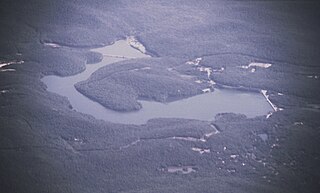
Monksville or Monks was a small settlement located in West Milford that was demolished and flooded to create the Monksville Reservoir in Passaic County, New Jersey, United States. The village was the home of James Monks, grand-uncle of Charles A. Monks of Passaic County, New Jersey.

Greenwood Lake is an interstate lake approximately seven miles (11 km) long, straddling the border of New York and New Jersey. It is located in the Town of Warwick and the Village of Greenwood Lake, New York and West Milford, New Jersey. It is the source of the Wanaque River.
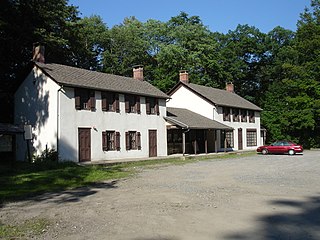
Long Pond Ironworks State Park is located in the community of Hewitt, in West Milford, New Jersey, United States. The park is known for its old stone walls, furnaces and other remnants of a once industrious ironworking community that now sits next to the swiftly flowing Wanaque River. The park is operated and maintained by the New Jersey Division of Parks and Forestry and has an area of 145 acres (0.59 km2).

The Kensico Reservoir is a reservoir spanning the towns of Armonk and Valhalla, New York, located 3 miles (5 km) north of White Plains. It was formed by the original earth and gravel Kensico Dam constructed in 1885, which impounded waters from the Bronx and Byram rivers. In 1917, a new masonry dam was completed, replacing the old dam and expanding the water supply by bringing water from the Catskill Mountains over a distance of more than 100 miles.

County Route 511 is a county highway in the U.S. state of New Jersey. The highway extends 37.44 miles (60.25 km) from Columbia Avenue in Morris Township to the New York state line in West Milford where the road continues as New York State Route 210.
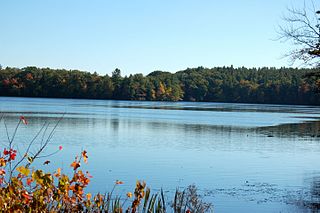
The Quinapoxet River is part of the Nashua River watershed in northern Massachusetts in the United States. It is part of the Massachusetts Water Resources Authority water system supplying drinking water to the greater Boston area.
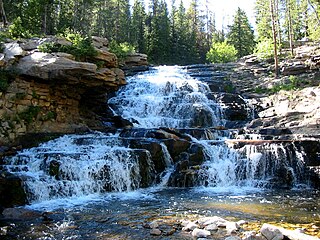
The Provo River is located in Utah County and Wasatch County, Utah, in the United States. It rises in the Uinta Mountains at Wall Lake and flows about 71 miles (114 km) southwest to Utah Lake at the city of Provo, Utah.

Spruce Run Recreation Area is a 1,290-acre (5.2 km2) New Jersey state recreation area located in Union Township and Clinton Township in Hunterdon County, New Jersey, United States. It encompasses the Spruce Run Reservoir that is used as a backup reservoir to protect the state from prolonged droughts. The reservoir is the third largest in the state, after Round Valley and Wanaque Reservoir. The reservoir is used for recreation purposes, including hunting, fishing, boating and swimming.

Ujjani Dam, also known as Bhima Dam or Bhima Irrigation Project, on the Bhima River, a tributary of the Krishna River, is an earthfill cum Masonry gravity dam located near Ujjani village of Madha Taluk in Solapur district of the state of Maharashtra in India.
Lake McConaughy is a reservoir on the North Platte River. It is located 9 miles (14 km) north of Ogallala, Nebraska, United States, near U.S. Highway 26 and Nebraska Highway 61. The reservoir was named for Charles W. McConaughy, a grain merchant and mayor of Holdrege, Nebraska, one of the leading promoters of the project. Although he did not live to see the completion of the project, his leadership and perseverance eventually culminated in a public power and irrigation project that helped Nebraska become one of the nation's leading agricultural states.

Wanaque Reservoir is a man-made lake located within Wanaque and Ringwood, New Jersey along the Wanaque River. The reservoir came into being in 1928 by the construction of the Raymond Dam along the river in Wanaque. Besides the Wanaque River, the reservoir receives water from two diversions: the Pompton Lakes intake, which takes water from the Ramapo River, and the Two Bridges intake, which takes water from the Pompton River. It is the second largest reservoir in New Jersey by volume, after Round Valley Reservoir. It is the second largest body of water in New Jersey by area, after Lake Hopatcong.
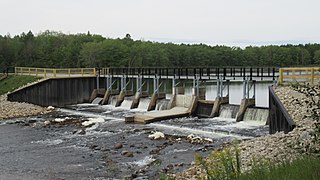
The Reedsburg Dam is a non-hydroelectric barrage dam crossing the Muskegon River in eastern Missaukee County in the U.S. state of Michigan. Located in rural Enterprise Township, the dam was constructed in 1940 by the Civilian Conservation Corps to alleviate flooding from Houghton Lake, which is the source of the Muskegon River approximately 6 miles (9.7 km) upstream.


